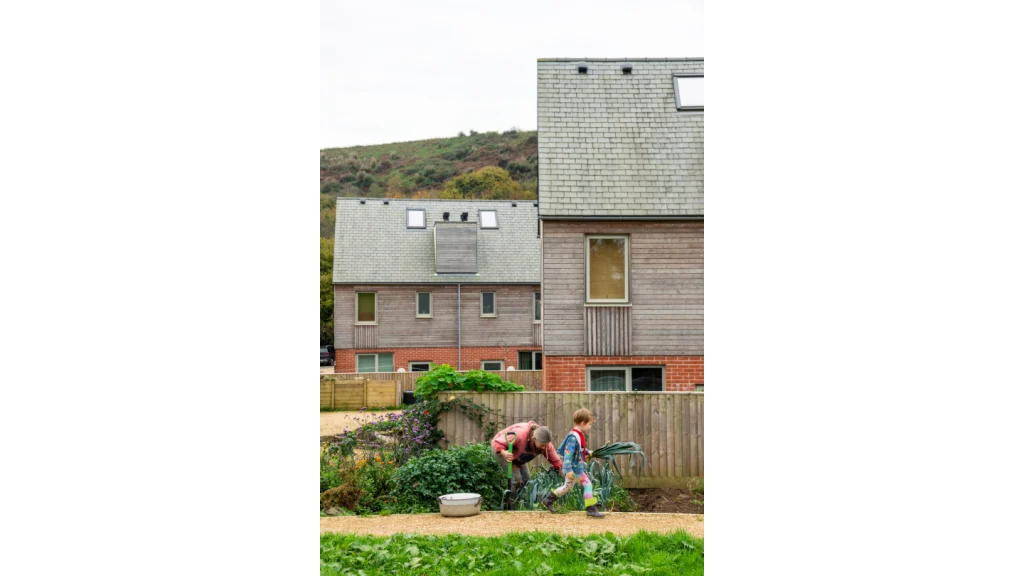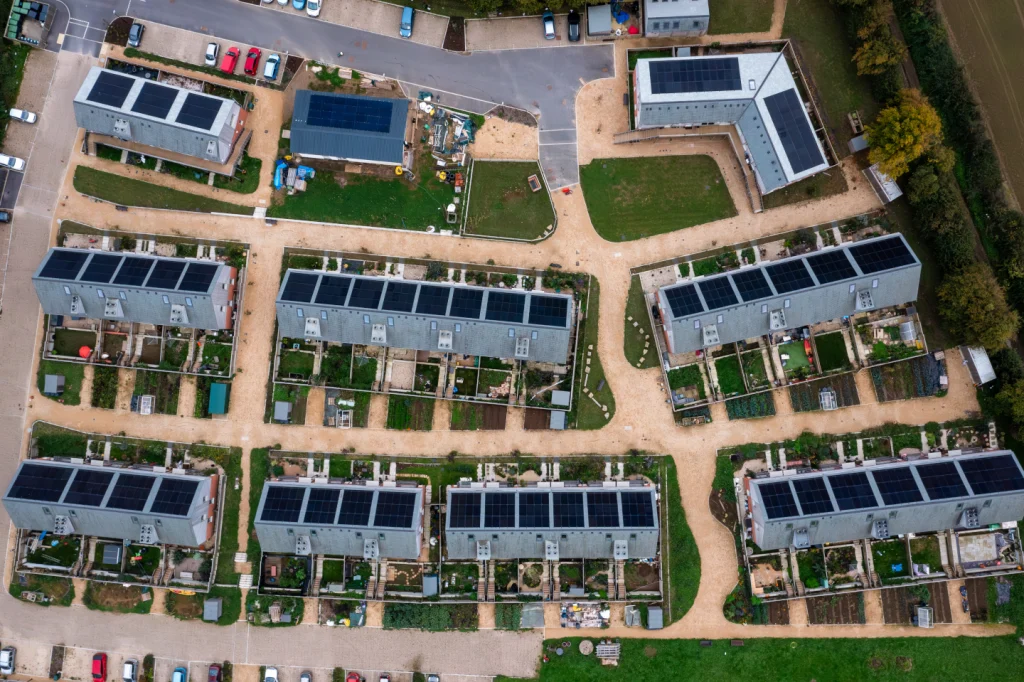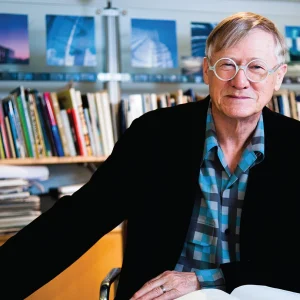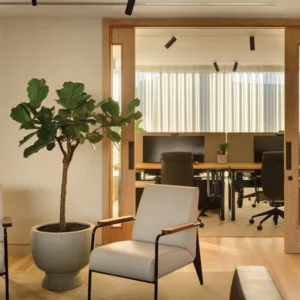
ON A GLORIOUS May day, I set out to investigate the newly completed Hazelmead Bridport Cohousing scheme – currently the UK’s largest cohousing project, with 53 homes. It was sun and blue skies all the way from Waterloo, and that spirit of spring, of fresh starts and high hopes, was present in the brick and timber-clad terraces that are set into this sloping greenfield site, next to Bridport’s hospital.
But as with every cohousing scheme I have ever encountered, over a decade of blood, sweat and tears, as well as frustrations with funding and run-ins with obtuse planning departments, was poured into this project. Why is cohousing such a hard concept to grasp for local authority planners as well as financers? It brings much-needed affordable housing, with a built-in community committed to looking after it, in perpetuity, and homes that add character to the townscape, unlike the soulless housing units thrown up by volume housebuilders. For the residents, cohousing is, as Barefoot Architects’ director Sam Goss tells us, ‘like having your cake and eating it’

‘You have your own house, with your own front door and your own private garden. You also have additional facilities in a common house, placed at the heart of the development for everyone to use.’ And as with most UK cohousing schemes, these spoils are distributed fairly to those who wouldn’t have the assets to find anything comparable, with local house prices currently in excess of 11 times the average income. Hazelmere is 50% social rent, and 50% shared ownership, with commitments to maintain all dwellings’ affordability in perpetuity (the Community Land Trust, which the cohousing group founded, retains a percentage of the ownership, to keep resale values low). A housing association operates the 14 social rent, one-bedroom apartments in the two blocks.
When Goss was brought on board, 15 years ago, he was 32, and working for Feilden Clegg Bradely in Bath. But he had also just built his parents a rammed earth dwelling in their back garden, completing it in 2010. The Bridport Cohousing group, which formed in 2008, visited this innovative home during a local green housing festival, and asked if Goss would take the project on, which he did.
And it feels clear, talking to him and his clients, that all the important boxes have been ticked for this new neighbourhood, backing onto an Area of Outstanding Natural Beauty. The six terraces are a mix of two, three and fourbedroom houses. As we walk past the front gardens, there are many bursting with healthy plants, but others a little wilder. We’re told that the ‘unplanted’ gardens are those belonging to NHS staff, who rent six of the homes, as one of the conditions of Bridport Cohousing’s arrangement with the adjacent hospital, in exchange for road access to the site. I can’t imagine a more tranquil place to return to after a long day in A&E. They are more forgiving of these members of the community for not contributing to the shared tasks.
After all, there is a certain amount expected of you as a member of a cohousing group. Namely, two hours a week of help in running the community and maintaining the buildings and landscape. Says resident Monica King: ‘You have to be a member. And people can’t be considered for living here until they have been a member for six months. You can see how committed they are in that time to the cohousing principles.’
The community had high aspirations for sustainability, which Goss has done his best to deliver. He says: ‘Our ambition was for Passivhaus but through D&B [design and build] procurement that wouldn’t have been possible. We went for AECB CarbonLite New Build Standard.’ Timber frames with MMCinsulated panels ensure low-carbon construction, with cladding in brick and larch. All terraces face south, with big, south-facing windows, and smaller north-facing windows. All south-facing roofs have solar panels, which feed into a community micro grid, run by a Bristol-based energy company. Each house has its own in-line air source heat pump, which sits on top of their hot water tank. Mechanical ventilation with heat recovery keeps temperatures steady all year round.

The interiors of the homes are impressive: spacious and filled with light. Says Goss: ‘We adopted Scottish building regulations… and then bettered them.’ Windows are large, and sit low in the wall so that you can still get a great view of the garden or the street when seated. Ceilings are higher than the minimum recommended (these are 2,550mm, compared with the standard 2,400mm). Windows are triple-glazed, the terraced houses have skylights over staircases, and upper floor ceilings are vaulted. Acoustics and insulation are also of a much higher standard.
There is a large area given over to vegetable growing – a degree of self-sufficiency was a major ambition. An orchard has also been planted in one of the two small fields at the top of the site, boundaried by ancient hedges. The other field is as yet undesignated, though ‘the children have already taken over that big oak tree, and built dens’ says King. She and her partner live in a one-bedroom socially rented apartment, which is every bit as lightfilled and spacious as the two-bedroomed houses we see.

An unfinished building sits at the centre of the site – the common house, a straw bale, timber frame project that currently has a roof, floors, ceilings, walls but no windows. Funding ran out for completing this prior to the residents moving in. Says Goss: ‘The group have been doing extraordinary work – selffunding and also self-building this.’
What were the worst moments during this long evolution? Residents cite the constantly shifting goalposts when funding or housing association partners change (there have been five up to now); the scheme also had to expand accommodation in order to fund Phase Two, bringing the total to over 50 homes, when 30 is considered optimal. It still represents incredible value for money: 50 homes for £9.5m costs (for 3,779m2 GIA).

Goss’s lowest point was ‘the first preapplication meeting with the local authority, when this group was being framed as private developers by planners. I decided let’s be the torchbearers and push into the dark places.’ They went to committee, and won. Barefoot now has a few cohousing and self-build schemes on its books, ‘and planning is a constant battle in every project we’re doing,’ says Goss. Though he’s frustrated by schemes being refused ‘on the basis of their being atypical’, now, he says, ‘I let it go to committee, because every time it goes to committee it gets through.’
He stayed motivated through the ups and downs, because ‘I’ve a real sense of compassion for the people who’ve been driving it. I’m really passionate about alternative housing. I’ve always believed in it.’ Hopefully, if a few more people read about this one, they will too.





